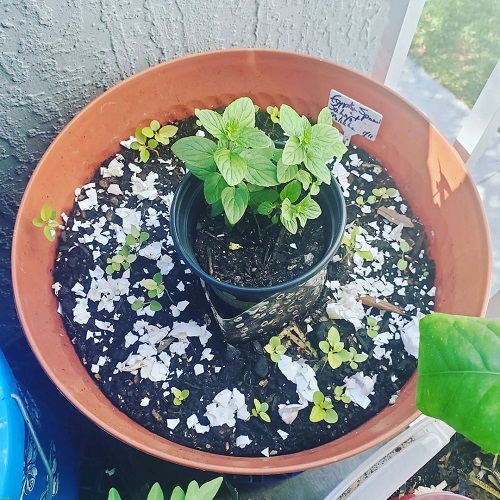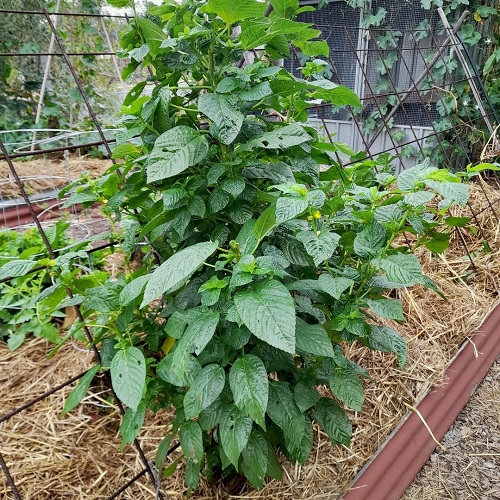Here’s everything about How to Grow Egyptian Spinach at Home to enjoy a fresh and organic harvest all year round!
W In this article, we will provide a step-by-step guide on How to Grow Egyptian Spinach at Home. It is easy and also a lot of fun!
Here are the best secrets to growing the sweetest spinach at home
Egyptian Spinach Plant Information
Egyptian Spinach, also known as Molokhia or Jew’s mallow, is a leafy green vegetable that is popular in Middle Eastern and North African cuisine. It is a nutritious and flavorful addition to any meal, and the best thing is – it is easy to grow at home. It is a staple food in Egypt, where it has been cultivated for thousands of years; that’s why it is named ‘Egyptian spinach.’
The plant is a member of the jute family and has long, slender leaves that are similar in appearance to spinach. Egyptian Spinach has medicinal properties and has been used in traditional medicine. It is a great addition to a healthy and varied diet, and it can be enjoyed in a wide range of dishes from around the world.
Botanical Name: Corchorus olitorius
USDA Zones: 5-11
Learn Growing Spinach in Containers and Care here
Growing Egyptian Spinach in a Container

To grow Egyptian Spinach in a container, pick a pot that’s at least 12 inches deep and 18 inches in diameter. It will give it all the space it needs to sprawl and produce a good harvest.
If the container does not have drainage holes, you can add a layer of stones at the bottom before adding the soil mix.
How to Grow Egyptian Spinach in a Container?
- Begin by selecting a container that is at least 12 inches deep and has drainage holes.
- Use a potting mix that is rich in organic matter, such as a mixture of topsoil and compost.
- Plant the Egyptian spinach seeds in the container, spacing them about 2 inches apart.
- Water the container thoroughly and keep the soil moist but not soggy.
- Place the container in a sunny location and keep the soil temperature above 70°F.
- Thin out the seedlings when they reach 4 to 6 inches in height, leaving only the strongest and most robust plants.
Check out 28 Best Types of Spinach to Grow in Pots here
Requirements for Growing Egyptian Spinach in a Container

Sunlight
Plant Egyptian Spinach in a location that receives at least 7-8 hours of direct sunlight per day. If growing in a container, place the container in a sunny spot on a balcony, patio, or another outdoor area.
The spinach may not reach its full potential if you grow it in shade.
Soil
When planting Egyptian spinach in a container, use good-quality potting soil that is rich in organic matter. The growing medium should be light and fluffy, with a pH of 6.5 to 7.5.
Learn How to Check Your Soil pH at Home here
A potting mix that is designed for vegetable gardens is ideal. To ensure optimum drainage, you can also add some perlite or coarse sand to the soil.
Water
The soil in the container should be kept evenly moist but not soggy to prevent root rot and nutrient deficiencies. Water your Egyptian spinach when the top 1-2 inches of soil feels dry to the touch.
Here are the best ways to water plants
Pour water slowly and evenly over the soil until it begins to seep out of the drainage holes. Be sure to empty any excess water that collects in the tray beneath the container.
Temperature
Egyptian Spinach prefers warm temperatures and can be grown outdoors in the warmer months (May through October) in USDA hardiness zones of 9 and above.
The soil temperature should be at least 60°F (15.5°C) for the seeds to germinate. During the day, keep the temperature around 70-75°F (21-24°C).
At night, the temperature should not drop below 60°F (15.5°C).
Egyptian Spinach Care
Fertilization
Use a balanced fertilizer with an N-P-K ratio of 10-10-10. Apply the fertilizer once every two weeks, using half the rate recommended on the packaging.
Want to Make Organic Fertilizers from Kitchen Scraps? Click here
Additionally, you can add a slow-release fertilizer to the container at planting time and top dress with compost or aged manure every couple of months.
Mulching
Mulching helps retain moisture in the soil, maintain soil temperature, and reduce weed growth. It can also help prevent the soil from eroding away.
When mulching Egyptian spinach in a container, use organic mulch like shredded leaves, grass clippings, or straw. Spread the mulch about 2 inches thick over the soil and around the plants. Make sure to leave a few inches of space between the mulch and the plant stems to allow for adequate air circulation.
Mulching should be done at least once a month or whenever the mulch begins to break down. It is also important to water the plants well before applying the mulch. This will help the mulch to stay in place. Reapply the mulch every few weeks or as needed.
Pests and Diseases
Pests:
Egyptian Spinach is susceptible to many pests, including aphids, caterpillars, cutworms, whiteflies, and flea beetles. You can use neem oil solution or insecticidal soap to get rid of pest issues.
Click here to learn the Amazing Natural Pesticide Recipe that can Kill any Pest
Diseases:
Common diseases that affect Egyptian Spinach include downy mildew, powdery mildew, and leaf spot. Make sure the plant gets plenty of sunlight and air circulation to keep potential diseases at bay.
Is Egyptian Spinach a Perennial Plant?

Yes, Egyptian spinach is a perennial plant in its native region of the Middle East and North Africa. In these regions, it grows year-round, taking advantage of the warm tropical climate. However, in other regions where the winters are cold, it may not survive the winter and is grown as an annual.
In warmer climates, Egyptian spinach can be grown as a perennial plant with proper care and maintenance. It will produce leaves year after year as a perennial, ensuring a constant supply of healthy, fresh greens.
To grow Egyptian spinach as a perennial plant, it is important to provide it with a warm and sunny location with well-draining soil. It requires regular watering and fertilization to maintain healthy growth. Additionally, you may need to prune the plant occasionally to keep it from getting too tall or leggy.
Check out our article on growing Spinach in pots here
Harvesting and Storing Egyptian Spinach Leaves

Harvesting
You can harvest Egyptian spinach leaves when they reach a height of 8-10 inches. It is best to cut the leaves off with scissors, leaving the roots intact so that the plant can continue to grow.
Storing
Egyptian spinach leaves should be stored in a cool, dry place in an airtight container. They can be stored in the refrigerator for up to 7 days. If the leaves are wilted, they can be refreshed by soaking them in cold water for 15 minutes.



